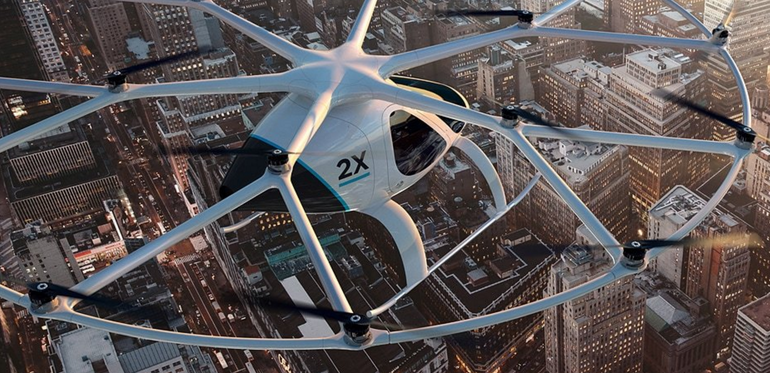Nowadays, a lot of people use different kind of services to go from location A to B. In the last few years, a lot of new taxi service applications are established, for example Uber, Lyft, and Gett. Imagine, that in maybe five years it will be possible to get your taxi ride in the air!
On Monday, 25th of September 2017, the world’s first taxi service in the air is tested in Dubai. The German company Volocopter designed this flying drone. The two seated drone, which looks more like a helicopter, has 18 propellers and a maximum flight duration of 30 minutes (Ibekwe, 2017).
During the test, the drone was unmanned and hovered upward about 200 meters and whirred for about five minutes. This taxi drone, also named Autonomous Air Taxi (AAT), has a cruise speed of 50 km/h, and a maximum airspeed of 100 km/h (Moon, 2017). The AAT is about two meters high, and the diameter is around seven meters. It is powered by nine batteries and featured by low noise levels, which makes the AAT an environmental friendly vehicle (Browning, 2017). During the evolvement of the production vehicles, all these features will be adapted.
Dubai strives to lead the Arab world in innovation. They believe that encouraging innovation and adopting the newest technologies, will build bridges into the future. Besides that, it will contribute to the country’s development to a high-tech, forward-looking society (Baldwin, 2017).
Dubai and Volocopter envision a future where it will be possible to book a flying taxi through an app. To make use of this flying taxi, you will need to go to the nearest ‘’voloport’’ where the AAT will pick you up. In the upcoming years, they will implement full sense capability. This will make it able to avoid obstacles and accidents with other flying vehicles (Reichert, 2017). If they will succeed, you can make yourself ready to make your first flying taxi ride within five years!
Bibliography
Baldwin, D. (2017) Watch: Dubai tests world’s first self-flying taxi. Retrieved on September 26, 2017 from http://gulfnews.com/news/uae/transport/watch-dubai-tests-world-s-first-self-flying-taxi-1.2095961
Browning, N. (2017) Dubai starts tests in bid to become first city with flying taxis. Retrieved on September 26, 2017 from https://www.reuters.com/article/us-emirates-dubai-drones/dubai-starts-tests-in-bid-to-become-first-city-with-flying-taxis-idUSKCN1C0232
Ibekwe, D. (2017) Dubai just tested its flying drone taxi for the first time. Retrieved on September 26, 2017 from http://www.businessinsider.com/dubai-flying-taxi-drone-volocopter-test-pilot-unmanned-2017-9?international=true&r=US&IR=T
Moon, M (2017) Dubai tests a passenger drone for its flying taxi service. Retrieved on September 26, 2017 fromhttps://www.engadget.com/2017/09/26/dubai-volocopter-passenger-drone-test/
Reichert, C. (2017) Dubai begins testing drone taxi service. Retrieved on September 26, 2017 from http://www.zdnet.com/article/dubai-begins-testing-drone-taxi-service/


